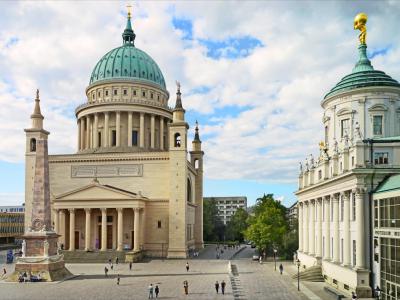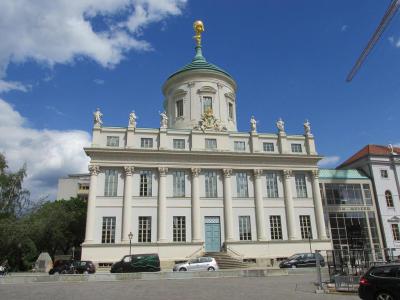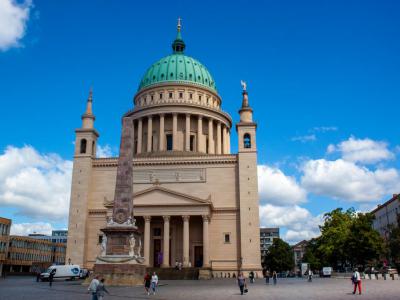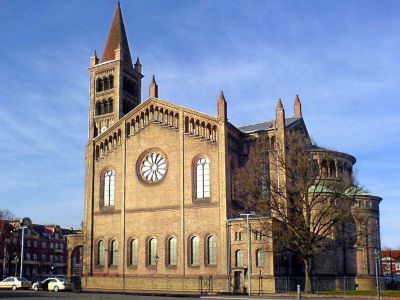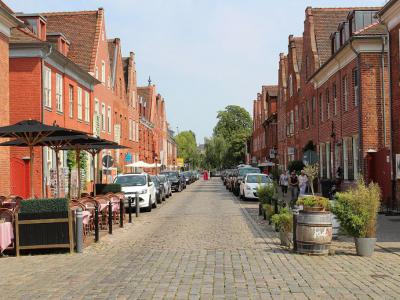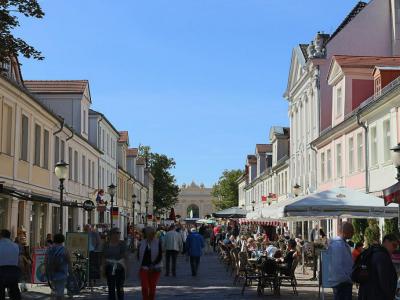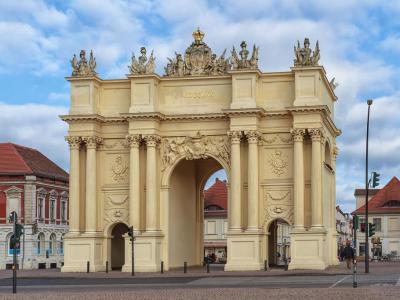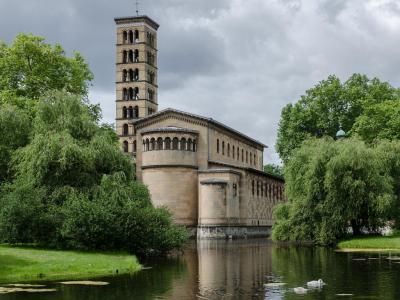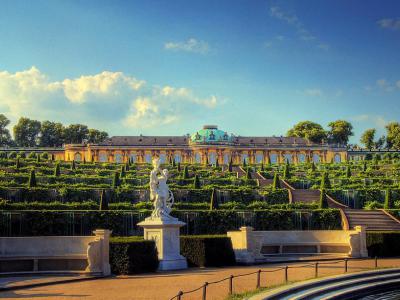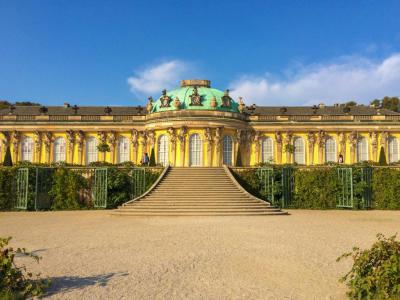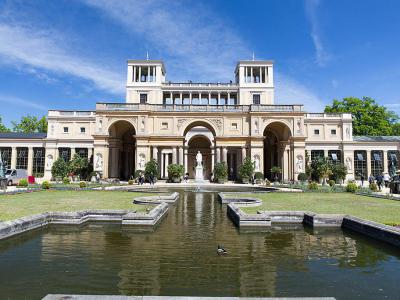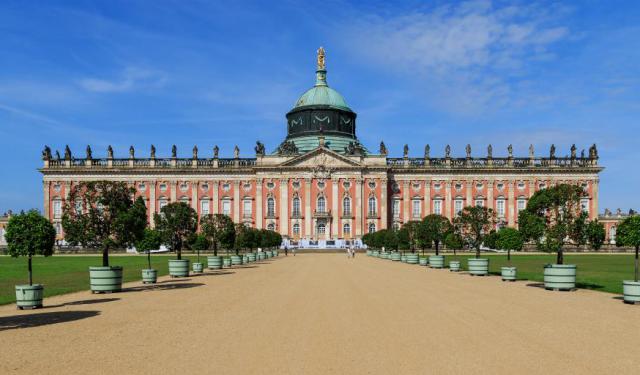
Potsdam Introduction Walking Tour (Self Guided), Potsdam
Potsdam was likely founded during the seventh century by the Hevelli tribe. The town was mentioned by the name of Poztupimi in a document from Emperor Otto III. The name likely came from an old Western Slavonic term roughly meaning "beneath the oaks."
By the early 1300s, a small town had formed with a town charter. By 1573 the town had around 2,000 people living there. Potsdam rose to prominence, however, when it became the hunting residence of Frederick William I, Elector of Brandenburg.
Brandenburg eventually became the Kingdom of Prussia, and Potsdam was a center for European culture and art. Religious freedoms attracted people from all over the continent. Potsdam maintained a steadfast dedication to its pastoral aesthetics with balanced architecture and landscapes.
As the city continued to grow, the Prussian royal family eventually settled there. Frederick the Great built many of the royal residences you can see today in the 18th century. Of the many sites you'll see around town from the era, don't miss the Brandenburg Gate, Old Market Square, Sanssouci Palace, and the palace's Terraced Gardens.
Potsdam remained a regional capital during the 19th and 20th centuries, even though the German Empire's principal capital was in nearby Berlin. Unfortunately, like many towns in Germany, Potsdam was severely damaged by World War II bombings.
Inside Potsdam's Cecilienhof Palace, Allied leaders decided to divide Germany after the war--an arrangement often called the Potsdam Agreement. In the following years, an effort was made by the East Germany government to remove many Prussian symbols and buildings, furthering the damage done by the war.
A lot has changed in Potsdam since reunification. Since the early 1990s, many efforts have been made to reconstruct historic structures and reestablish Potsdam to its beautiful historical glory. Don't miss Brandenburger Street for some modern amenities or the beautiful architecture at Saint Peter and Paul Church, Old City Hall, or Orangery Palace.
Potsdam is, without a doubt, one of the most beautiful cities in all of Europe. So get ready to see the sights--join us on this self-guided walking tour of this fantastic city.
By the early 1300s, a small town had formed with a town charter. By 1573 the town had around 2,000 people living there. Potsdam rose to prominence, however, when it became the hunting residence of Frederick William I, Elector of Brandenburg.
Brandenburg eventually became the Kingdom of Prussia, and Potsdam was a center for European culture and art. Religious freedoms attracted people from all over the continent. Potsdam maintained a steadfast dedication to its pastoral aesthetics with balanced architecture and landscapes.
As the city continued to grow, the Prussian royal family eventually settled there. Frederick the Great built many of the royal residences you can see today in the 18th century. Of the many sites you'll see around town from the era, don't miss the Brandenburg Gate, Old Market Square, Sanssouci Palace, and the palace's Terraced Gardens.
Potsdam remained a regional capital during the 19th and 20th centuries, even though the German Empire's principal capital was in nearby Berlin. Unfortunately, like many towns in Germany, Potsdam was severely damaged by World War II bombings.
Inside Potsdam's Cecilienhof Palace, Allied leaders decided to divide Germany after the war--an arrangement often called the Potsdam Agreement. In the following years, an effort was made by the East Germany government to remove many Prussian symbols and buildings, furthering the damage done by the war.
A lot has changed in Potsdam since reunification. Since the early 1990s, many efforts have been made to reconstruct historic structures and reestablish Potsdam to its beautiful historical glory. Don't miss Brandenburger Street for some modern amenities or the beautiful architecture at Saint Peter and Paul Church, Old City Hall, or Orangery Palace.
Potsdam is, without a doubt, one of the most beautiful cities in all of Europe. So get ready to see the sights--join us on this self-guided walking tour of this fantastic city.
How it works: Download the app "GPSmyCity: Walks in 1K+ Cities" from Apple App Store or Google Play Store to your mobile phone or tablet. The app turns your mobile device into a personal tour guide and its built-in GPS navigation functions guide you from one tour stop to next. The app works offline, so no data plan is needed when traveling abroad.
Potsdam Introduction Walking Tour Map
Guide Name: Potsdam Introduction Walking Tour
Guide Location: Germany » Potsdam (See other walking tours in Potsdam)
Guide Type: Self-guided Walking Tour (Sightseeing)
# of Attractions: 11
Tour Duration: 2 Hour(s)
Travel Distance: 3.8 Km or 2.4 Miles
Author: nataly
Sight(s) Featured in This Guide:
Guide Location: Germany » Potsdam (See other walking tours in Potsdam)
Guide Type: Self-guided Walking Tour (Sightseeing)
# of Attractions: 11
Tour Duration: 2 Hour(s)
Travel Distance: 3.8 Km or 2.4 Miles
Author: nataly
Sight(s) Featured in This Guide:
- Old Market Square
- Old City Hall
- St. Nicholas' Church
- Saint Peter und Paul Kirche (St Peter and Paul Church)
- Dutch Quarter
- Brandenburger Street
- Brandenburg Gate
- Protestant Church of Peace
- Terraced Gardens
- Sanssouci Palace
- Orangery Palace
1) Old Market Square
Old Market Square is located directly in front of St. Nicholas’s Church. The square features many beautiful historic buildings that have been reconstructed since World War II.
The square originally centered around the City Palace, which was built in 1662. City Palace served as the winter palace of Branderburg’s margraves and electors, kings of Prussia, and German emperors.
During the 1700s, Prussian king Frederick the Great transformed the square into a Roman piazza.
Old City Hall was built from 1753 to 1755. The square’s marble obelisk was added in 1753. The obelisk was created by architect Georg Wenzeslaus von Knobelsdorff and designed to promote the square’s Roman look. The obelisk originally featured depictions of former rulers and kings, which were replaced by portraits of Potsdam architects.
St. Nicholas’ Church was built from 1830 to 1837 and features a classical design. The square also features the Pompei Palace, which is a replica of Verona’s Pompei Palace. The Museum Barberini is a rebuilt version of the original Barberini Palace.
The square’s historic buildings were damaged during World War II bombing raids. The City Palace was then torn down in the 1960s. The City Palace has since been partially reconstructed as the State Parliament of Brandenburg (Landtag of Brandenburg). The reconstruction features a historic facade that matches the old City Palace. The new building houses Brandenburg’s parliament and has a modern interior.
The rebuilt pedestrian-only Old Market Square is a popular site for photos of the square’s impressive architecture.
The square originally centered around the City Palace, which was built in 1662. City Palace served as the winter palace of Branderburg’s margraves and electors, kings of Prussia, and German emperors.
During the 1700s, Prussian king Frederick the Great transformed the square into a Roman piazza.
Old City Hall was built from 1753 to 1755. The square’s marble obelisk was added in 1753. The obelisk was created by architect Georg Wenzeslaus von Knobelsdorff and designed to promote the square’s Roman look. The obelisk originally featured depictions of former rulers and kings, which were replaced by portraits of Potsdam architects.
St. Nicholas’ Church was built from 1830 to 1837 and features a classical design. The square also features the Pompei Palace, which is a replica of Verona’s Pompei Palace. The Museum Barberini is a rebuilt version of the original Barberini Palace.
The square’s historic buildings were damaged during World War II bombing raids. The City Palace was then torn down in the 1960s. The City Palace has since been partially reconstructed as the State Parliament of Brandenburg (Landtag of Brandenburg). The reconstruction features a historic facade that matches the old City Palace. The new building houses Brandenburg’s parliament and has a modern interior.
The rebuilt pedestrian-only Old Market Square is a popular site for photos of the square’s impressive architecture.
2) Old City Hall
The first city hall was built in 1524 but destroyed in 1536 during a terrible fire. The second city hall was used from 1536 to 1722 when a larger hall was needed. The third hall was only used for thirty years before the city again needed a larger hall.
The current Old City Hall was built between 1753 and 1755. Architects Carl Ludwig Hildebrant and Jan Bouman designed the square under King Frederick’s direction. Old City Hall’s facade is a copy of a facade designed by Andrea Palladio for Vicenza’s Count of Angarano.
This beautiful building actually served as the town jail from 1755 to 1875. The city council finally moved into the building in 1875, and the jail continued to operate in a portion of the building. Then, in 1916, the city council moved into the Barberini Palace.
Old City Hall features a dramatic statue depicting Atlas. The architects had planned on featuring a Roman god. However, they got confused and chose the Greek Titan Atlas. The statue was originally decorated with gold-plated leaves, which fell off within two years.
Today, the Atlas statue has gold-plated copper and has survived every catastrophe over its history. Residents don’t appreciate mythology and call the statue “The Doll”. When the city hall housed the jail, it was known as “The Doll-House”.
Old City Hall was damaged during World War II bombing raids and reconstructed during the 1960s. Today, Old City Hall houses a portion of the Potsdam Museum and hosts exhibitions, conferences, and lectures.
The current Old City Hall was built between 1753 and 1755. Architects Carl Ludwig Hildebrant and Jan Bouman designed the square under King Frederick’s direction. Old City Hall’s facade is a copy of a facade designed by Andrea Palladio for Vicenza’s Count of Angarano.
This beautiful building actually served as the town jail from 1755 to 1875. The city council finally moved into the building in 1875, and the jail continued to operate in a portion of the building. Then, in 1916, the city council moved into the Barberini Palace.
Old City Hall features a dramatic statue depicting Atlas. The architects had planned on featuring a Roman god. However, they got confused and chose the Greek Titan Atlas. The statue was originally decorated with gold-plated leaves, which fell off within two years.
Today, the Atlas statue has gold-plated copper and has survived every catastrophe over its history. Residents don’t appreciate mythology and call the statue “The Doll”. When the city hall housed the jail, it was known as “The Doll-House”.
Old City Hall was damaged during World War II bombing raids and reconstructed during the 1960s. Today, Old City Hall houses a portion of the Potsdam Museum and hosts exhibitions, conferences, and lectures.
3) St. Nicholas' Church (must see)
St. Nicholas Church is one of Potsdam’s most iconic landmarks. Its distinctive dome can be seen throughout the city. Frederick William III commissioned the church, which was designed by Karl Friedrich Schinkel and built from 1830 to 1837. It was designed to replace the old St. Nicholas church that burned down in 1795. Christopher Wren’s acclaimed St. Paul’s Cathedral in London inspired the Classicist church with Italian flair.
The church’s original design looked like a cube. The church’s appearance was completely altered when the dome was added between 1843 and 1850. The dramatic tambour is 77 meters high (253 feet). The church’s interior is 52 meters high (171 feet).
The church was damaged during World War II bombs and rebuilt. Today, St. Nicholas Church is open to the public and often hosts concerts. In addition, visitors can climb the tower to enjoy spectacular views of the city from the 42-meter tall (138-foot) viewing platform.
The church’s original design looked like a cube. The church’s appearance was completely altered when the dome was added between 1843 and 1850. The dramatic tambour is 77 meters high (253 feet). The church’s interior is 52 meters high (171 feet).
The church was damaged during World War II bombs and rebuilt. Today, St. Nicholas Church is open to the public and often hosts concerts. In addition, visitors can climb the tower to enjoy spectacular views of the city from the 42-meter tall (138-foot) viewing platform.
4) Saint Peter und Paul Kirche (St Peter and Paul Church)
The Roman Catholic St Peter and Paul Church was built between 1867 and 1870 to replace an older church that fell into disrepair. August Stüler and Wilhelm Salzberg designed St Peter and Paul Church. The church has a symmetrical design and features a mix of Byzantine, Romanesque, and classicist styles.
The church was built with distinctive yellow brick and features an Italian-style bell tower modeled on Verona’s San Zeno tower. The tower is almost 63 meters high (207 feet).
The interior’s altars were crafted from exquisite marble. The church features three of Antoine Pesne’s Baroque masterpieces from the original church. In addition, the walls have beautiful images depicting The Way of the Cross and many ornamental murals.
The impressive organ was designed by Schuke in 1936 and has 41 registers.
The church was damaged during World War II and has since been restored. The church is open to the public and often hosts lectures on religion, architecture, and travel.
The church was built with distinctive yellow brick and features an Italian-style bell tower modeled on Verona’s San Zeno tower. The tower is almost 63 meters high (207 feet).
The interior’s altars were crafted from exquisite marble. The church features three of Antoine Pesne’s Baroque masterpieces from the original church. In addition, the walls have beautiful images depicting The Way of the Cross and many ornamental murals.
The impressive organ was designed by Schuke in 1936 and has 41 registers.
The church was damaged during World War II and has since been restored. The church is open to the public and often hosts lectures on religion, architecture, and travel.
5) Dutch Quarter (must see)
The Dutch Quarter is also known as Little Amsterdam. Frederick William I commissioned the district to attract skilled artisans from the Netherlands. Frederick William I intended to expand Potsdam but needed skilled labor to help, so he offered workers housing and work contracts. The king particularly sought masons, cabinet-makers, and goldsmiths.
The Dutch Quarter was built by Dutch architect Jan Bouman and completed in 1742. This unique area has four squares and 134 two-story houses. The houses weren’t all occupied by Dutch artisans as originally planned. Instead, however, they also housed Prussian and French artists, merchants, and soldiers.
The terraced houses feature red Dutch brick with white accents, shutters, and distinctive gables. This beautiful district only suffered minor damage during World War II, but time still took its toll, and the buildings fell into disrepair after the World War II. However, the area was restored during the 1970s and is now one of Potsdam’s main tourist attractions.
Jan Bouman’s home is considered one of Potsdam’s first urban houses and is open to the public as a museum. The home features a main house, half-timbered outbuildings, and a home garden. Inside, visitors will see a spinning wheel, furniture, and cooking implements from the 18th century.
The district features galleries, craft shops, and backyard pubs. Visitors can walk along the cobbled streets and enjoy shopping at charming boutiques. Visitors can also see the house Mozart lived in during 1789.
The Dutch Quarter hosts several festivals throughout the year, including the Tulip Festival. The Dutch Christmas market is another popular annual event.
The Dutch Quarter was built by Dutch architect Jan Bouman and completed in 1742. This unique area has four squares and 134 two-story houses. The houses weren’t all occupied by Dutch artisans as originally planned. Instead, however, they also housed Prussian and French artists, merchants, and soldiers.
The terraced houses feature red Dutch brick with white accents, shutters, and distinctive gables. This beautiful district only suffered minor damage during World War II, but time still took its toll, and the buildings fell into disrepair after the World War II. However, the area was restored during the 1970s and is now one of Potsdam’s main tourist attractions.
Jan Bouman’s home is considered one of Potsdam’s first urban houses and is open to the public as a museum. The home features a main house, half-timbered outbuildings, and a home garden. Inside, visitors will see a spinning wheel, furniture, and cooking implements from the 18th century.
The district features galleries, craft shops, and backyard pubs. Visitors can walk along the cobbled streets and enjoy shopping at charming boutiques. Visitors can also see the house Mozart lived in during 1789.
The Dutch Quarter hosts several festivals throughout the year, including the Tulip Festival. The Dutch Christmas market is another popular annual event.
6) Brandenburger Street
Brandenburger Street is a popular shopping street that starts at the Brandenburg Gate and continues to the iconic St Peter and Paul Church. The street was created during Friedrich Wilhelm I’s expansion. Originally, the street was residential and housed craftsmen. These craftsmen were obliged to house soldiers from the Prussian army. Each home housed four to six soldiers.
At the end of the 19th century, the street became a commercial street instead of a residential street. Today, it is a pedestrian-only street and features a mix of popular chains and boutiques.
Visit specialty shops or stop at one of the popular cafes and restaurants. The cafes feature outdoor dining to enjoy the summer weather and people watching while planning your shopping experience.
Brandenburger Street decorates for the winter holidays and hosts a popular Christmas market every year.
At the end of the 19th century, the street became a commercial street instead of a residential street. Today, it is a pedestrian-only street and features a mix of popular chains and boutiques.
Visit specialty shops or stop at one of the popular cafes and restaurants. The cafes feature outdoor dining to enjoy the summer weather and people watching while planning your shopping experience.
Brandenburger Street decorates for the winter holidays and hosts a popular Christmas market every year.
7) Brandenburg Gate (must see)
Brandenburg Gate was originally built in 1733 as a simple, functional gate. The gate stood at an important crossroad as the country road leading to Brandenburg began at the gate. The gate also connected to the roads leading to Potsdam’s royal palaces and gardens.
Frederick William I, known as Frederick the Great, intended to expand the city. He wanted to celebrate Prussia’s greatness with a majestic gate. Carl von Gontard and Georg Christian Unger designed the new gate to emulate a Roman triumphal arch.
The gate’s field side features classic architecture with Corinthian double columns. The field side also has war trophy depictions, coats of arms, and ornamentation. The gate’s city side has trophies and Corinthian pilaster strips.
Pedestrian entrances were added in 1843. The gate was originally connected to the city walls but became free-standing around 1900.
Frederick William I, known as Frederick the Great, intended to expand the city. He wanted to celebrate Prussia’s greatness with a majestic gate. Carl von Gontard and Georg Christian Unger designed the new gate to emulate a Roman triumphal arch.
The gate’s field side features classic architecture with Corinthian double columns. The field side also has war trophy depictions, coats of arms, and ornamentation. The gate’s city side has trophies and Corinthian pilaster strips.
Pedestrian entrances were added in 1843. The gate was originally connected to the city walls but became free-standing around 1900.
8) Protestant Church of Peace
The Protestant Church of Peace is tucked into Sanssouci Park’s tranquil gardens. King Frederick William IV commissioned the church and Ludwig Persius designed it. After Persus’ death, Friedrich August Stüler continued the construction work. The cornerstone was laid in 1845, and the building was completed in 1854.
The church is reminiscent of a Medieval Italian monastery and is part of the UNESCO World Heritage Site Palaces and Parks of Potsdam and Berlin. King Frederick William IV made the original design sketches and wanted the church to resemble Rome’s Basilica di San Clemente.
The king also wanted the church to display a 13th-century mosaic he had purchased from a Venetian church. This mosaic decorates the church’s apse and features religious figures and a Latin inscription.
The altar canopy was a gift from the king’s brother-in-law, Russia’s Tsar Nicholas I. The canopy was installed in 1842 and features Siberian jasper columns. The church’s floor features an intricate design of interleaved ribbon that represents eternity.
Frederick William IV and his wife are interred in the church’s royal crypt. At the end of the 19th century, the Kaiser Friedrich Mausoleum was added to the church’s north side. Emperor Friedrich III and his wife, Empress Victoria, are interred in a marble sarcophagus. The mausoleum also houses Soldier-King Frederick William I’s coffin.
The church’s 42-meter high (138-foot) belltower was inspired by the design of Rome’s Santa Maria in Cosmedin. The tower has seven open-air floors.
The church is reminiscent of a Medieval Italian monastery and is part of the UNESCO World Heritage Site Palaces and Parks of Potsdam and Berlin. King Frederick William IV made the original design sketches and wanted the church to resemble Rome’s Basilica di San Clemente.
The king also wanted the church to display a 13th-century mosaic he had purchased from a Venetian church. This mosaic decorates the church’s apse and features religious figures and a Latin inscription.
The altar canopy was a gift from the king’s brother-in-law, Russia’s Tsar Nicholas I. The canopy was installed in 1842 and features Siberian jasper columns. The church’s floor features an intricate design of interleaved ribbon that represents eternity.
Frederick William IV and his wife are interred in the church’s royal crypt. At the end of the 19th century, the Kaiser Friedrich Mausoleum was added to the church’s north side. Emperor Friedrich III and his wife, Empress Victoria, are interred in a marble sarcophagus. The mausoleum also houses Soldier-King Frederick William I’s coffin.
The church’s 42-meter high (138-foot) belltower was inspired by the design of Rome’s Santa Maria in Cosmedin. The tower has seven open-air floors.
9) Terraced Gardens (must see)
The Terraced Gardens are an impressive part of the Sanssouci Palace. This location was previously a wooded vista. However, Frederick William I wanted to transform the area. In 1744, the hillside was changed into six terraces.
The terraces feature convex centers that maximize sunlight. One hundred sixty-eight glazed niches are featured among the wall’s brickwork.
Trellised vines were planted in front of the bricks, and figs were planted in the niches. The terraces also have strips of lawn with yew trees. The gardens feature a circular ornamental parterre created with trellised fruit hedging. One hundred and thirty-two steps lead downward and divide the terraces.
Below the terraces, visitors will find a beautiful ornamental garden. The “Great Fountain” was built in 1748. Then, in 1750, marble statues were added around the fountain. This idea was copied from Versailles and the French King Louis XV gifted several statues, including Venus and Mercury. The other statues represent Apollo, Diana, Jupiter, Mars, Juno, and Minerva.
The terraces feature convex centers that maximize sunlight. One hundred sixty-eight glazed niches are featured among the wall’s brickwork.
Trellised vines were planted in front of the bricks, and figs were planted in the niches. The terraces also have strips of lawn with yew trees. The gardens feature a circular ornamental parterre created with trellised fruit hedging. One hundred and thirty-two steps lead downward and divide the terraces.
Below the terraces, visitors will find a beautiful ornamental garden. The “Great Fountain” was built in 1748. Then, in 1750, marble statues were added around the fountain. This idea was copied from Versailles and the French King Louis XV gifted several statues, including Venus and Mercury. The other statues represent Apollo, Diana, Jupiter, Mars, Juno, and Minerva.
10) Sanssouci Palace (must see)
Sanssouci Palace was built by Frederick the Great between 1745 and 1747 and served as his summer palace. The palace’s name means “without concern,” alluding to its function as a restful retreat.
Frederick the Great wanted to cultivate grapes, figs, and plums and designed a terrace and gardens. The restful palace was Frederick the Great’s favorite residence. The palace has a grand facade but originally had just ten main rooms located on a single level.
Sanssouci Palace features Rococo style with ornate reliefs and elaborate tapestries. The style is so unique that it is known as Frederician Rococo.
The interior features beautiful architecture. The Concert Room hosted the king’s flute concerts. The Fourth Guest Room is thought to be the room that renowned philosopher Voltaire stayed in when visiting Sanssouci. The Library has cedar paneling and houses about 2000 books. During Frederick’s reign, the books were all in French, as French was thought to be more elite than German.
Frederick the Great’s tomb is located on the palace’s highest terrace. He was buried next to his beloved dogs in his favorite place on earth.
Frederick William IV enlarged the palace during the 19th century. The palace now operates as a museum and is part of the UNESCO World Heritage Site. The palace is located in Sanssouci Park, which features several buildings, including the New Palace, Chinese House, Dragon House, Roman Baths, and the Church of Peace.
In the summer, the palace hosts Potsdam Palace Nights. The gardens are lit up, and guests are treated to classical music. Actors dress in period costumes and mingle with guests. The palace also hosts dance and theater performances as well as lectures. On the weekends, the night ends with midnight fireworks.
Frederick the Great wanted to cultivate grapes, figs, and plums and designed a terrace and gardens. The restful palace was Frederick the Great’s favorite residence. The palace has a grand facade but originally had just ten main rooms located on a single level.
Sanssouci Palace features Rococo style with ornate reliefs and elaborate tapestries. The style is so unique that it is known as Frederician Rococo.
The interior features beautiful architecture. The Concert Room hosted the king’s flute concerts. The Fourth Guest Room is thought to be the room that renowned philosopher Voltaire stayed in when visiting Sanssouci. The Library has cedar paneling and houses about 2000 books. During Frederick’s reign, the books were all in French, as French was thought to be more elite than German.
Frederick the Great’s tomb is located on the palace’s highest terrace. He was buried next to his beloved dogs in his favorite place on earth.
Frederick William IV enlarged the palace during the 19th century. The palace now operates as a museum and is part of the UNESCO World Heritage Site. The palace is located in Sanssouci Park, which features several buildings, including the New Palace, Chinese House, Dragon House, Roman Baths, and the Church of Peace.
In the summer, the palace hosts Potsdam Palace Nights. The gardens are lit up, and guests are treated to classical music. Actors dress in period costumes and mingle with guests. The palace also hosts dance and theater performances as well as lectures. On the weekends, the night ends with midnight fireworks.
11) Orangery Palace (must see)
King Frederick William IV of Prussia built the Orangery Palace from 1851 to 1864. It was originally part of a larger plan with more buildings. However, only the Orangery Palace and the Triumphtor Gate were built due to political unrest and a lack of funds.
Architects Friedrich August Stüler, Friedrich Ludwig Persius, and Ludwig Ferdinand Hesse designed the palace. The palace features Italian Renaissance style and has a 300 meter long (984 foot) front. The main palace has two towers and is flanked by two side wings. The side wings house public offices.
King Frederick William IV’s wife commissioned a statue of her husband, which is now displayed in front of the peristyle.
Raffael Hall is located in the main palace and has 50 copies of Raffael’s paintings. The beautiful hall has a large skylight, and the paintings are displayed on walls covered with red silk. Raffael Hall emulates the Vatican’s Sala Regia and has been open to the public since its inception.
The Orangery Palace’s grounds feature several gardens, including the Paradise Gardens, Botanical Gardens, Norse Garden, and Sicilian Garden. The Orangery was named a UNESCO World Heritage Site in 1990.
Architects Friedrich August Stüler, Friedrich Ludwig Persius, and Ludwig Ferdinand Hesse designed the palace. The palace features Italian Renaissance style and has a 300 meter long (984 foot) front. The main palace has two towers and is flanked by two side wings. The side wings house public offices.
King Frederick William IV’s wife commissioned a statue of her husband, which is now displayed in front of the peristyle.
Raffael Hall is located in the main palace and has 50 copies of Raffael’s paintings. The beautiful hall has a large skylight, and the paintings are displayed on walls covered with red silk. Raffael Hall emulates the Vatican’s Sala Regia and has been open to the public since its inception.
The Orangery Palace’s grounds feature several gardens, including the Paradise Gardens, Botanical Gardens, Norse Garden, and Sicilian Garden. The Orangery was named a UNESCO World Heritage Site in 1990.
Walking Tours in Potsdam, Germany
Create Your Own Walk in Potsdam
Creating your own self-guided walk in Potsdam is easy and fun. Choose the city attractions that you want to see and a walk route map will be created just for you. You can even set your hotel as the start point of the walk.
Neuer Garten Walking Tour
Laid out at the behest of Friedrich William II in 1787, Potsdam's Neuer Garten (New Garden) was indeed "new" compared to the already in place Sanssouci Park.
Between 1816 and 1828, the area was modified further as an English-style, open landscape garden, with an aim to reproduce nature – trees and plants were left to grow naturally, unshaped and untrimmed. Rural life was also... view more
Tour Duration: 2 Hour(s)
Travel Distance: 2.8 Km or 1.7 Miles
Between 1816 and 1828, the area was modified further as an English-style, open landscape garden, with an aim to reproduce nature – trees and plants were left to grow naturally, unshaped and untrimmed. Rural life was also... view more
Tour Duration: 2 Hour(s)
Travel Distance: 2.8 Km or 1.7 Miles
Sanssouci Park Walking Tour
Sanssouci Park is a unique Potsdam landmark that occupies 290 hectares in the heart of the city. The Park is named after the Sanssouci Palace that it surrounds, which in turn takes its name from the French phrase "sans souci", which means carefree, and implies that the palace was designated as a place of fun, rather than a seat of power.
Indeed, the Sanssouci Palace was built in 1747... view more
Tour Duration: 2 Hour(s)
Travel Distance: 3.9 Km or 2.4 Miles
Indeed, the Sanssouci Palace was built in 1747... view more
Tour Duration: 2 Hour(s)
Travel Distance: 3.9 Km or 2.4 Miles
The Most Popular Cities
/ view all
